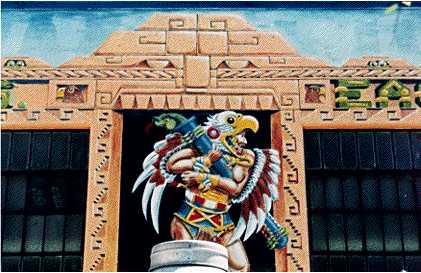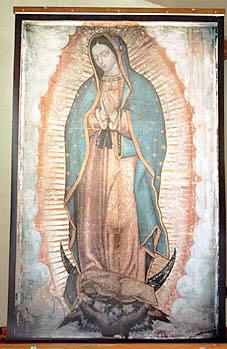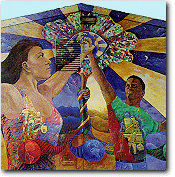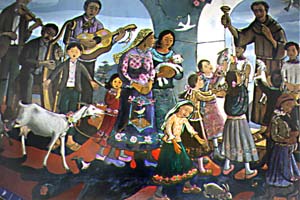
Southside of Venice Ave. just east of Union Blvd.
Photo ©1997 by Richard Davidon
Used by Permission

The murals in Los Angeles and Southern California are one of the best examples of the power of public art and an important part of our cultural heritage. Though murals have been present in the area since the early 1900's, the Hispanic community has
played the leading role in the mural painting renaissance that
came as a result of the civil rights struggles of the 1960's. The
murals are an important tool for social and political expression.
Today there are over a thousand public murals throughout the area. |

Why murals? Some consider public murals to be not far
removed from grafitti, unworthy of being called "art."
A mural is defined as a picture on a wall or ceiling. Muralism as an art form has been around for a very long time. In fact, the
cave art paintings of many cultures throughout the world are
considered murals and have remained remarkably well preserved
even after thousands of years in some cases. Murals can be found
in the great civilizations of Rome and Greece and Egypt among
many others. This is hardly a new art form.
|

| The most powerful influences on modern muralism in California were the three great Mexican muralists, Diego Rivera, David Alfaro Siquieros and Jose Clemente Orozco. In 1922 they were commissioned to paint murals on public buildings that could be easily understood by the "common man" and would glorify precolonial Mexico as well as the 1917 Revolution, themes that were later incorporated into many murals here. All three spent time in the U.S. though none of them was on hand to witness the muralist renaissance in the Chicano communities of California during the 1960's. Rivera and Siquieros' work was more political, deeply influenced by their leftist sympathies, while Orozco tended to focus on less controversial themes. Two common themes appear in the murals of Los Angeles and San Fransisco's Mission District. One continues the Mexican tradition of glorifying the indigenous cultures of the Americas, past and present. This shows the continuity of history, the presence and contribution of a people to society through time.The other is an emphasis on a multicultural society, both in its value as in its shortcomings. It is important to note that the societies of Latin America have deep influences of many cultures. |

The Virgin of Guadalupe
photo ©1997 by Richard Davidon
Used by Permission
| The murals of Los Angeles over the years have evolved to adapt to changing realities. There has been a softening of some of the revolutionary and nationalist aspects inherited from Rivera and his colleagues. The dominant event in their lives was the Mexican Revolution of 1917. The new generation of muralist remains concerned with the wider issues of civil rights and social justice. However, their points of reference and the dominant influences on their lives are quite different. There has been a greater emphasis on the issues of the neighborhood. Some of these themes are about life and death, youth, education, economic opportunity, the relationship with the police, gangs, and many others. A common theme remains cultural identity and tradition. An important influence in Hispanic culture is religion and the murals often contain religious themes, the Virgin of Guadalupe, for example, is often present in a lot of murals. It should also be pointed out that though many murals deal with political issues and some negative themes, just as many celebrate the more positive aspects. Like life, it is a reflection of good and bad, not just one or the other. |

| Los Angeles has become much more diverse over the years, with the resulting pressures for assimilation. Government has taken on the task of funding mural projects for a number of reasons. One obvious reason is city beautification. There is obvious value in having colorful works of art. There is a sense of life and movement about them. But more importantly, people feel that they have a direct stake in the murals, they talk about their lives, their culture, and often involve artists that are from the neighborhood. Many publicly sponsored mural projects celebrate multicultural society and the importance of living and working together peacefully. They can lead to an appreciation of our differences and similarities and a respect for these. One of the best examples of this is the "Great Wall of Los Angeles," which celebrates the history of the city and the contributions that different communities have made. Many urban centers throughout the United States have also begun mural projects after appreciating the value of public murals. |

Primary Source: Street
Gallery-a Guide to 1000 Los Angeles Murals
(RJD Enterprises, Los Angeles, 1993) by Robin J. Donitz
A
short history of the Chicano Murals
Mural Conservancy of
Los Angeles
Murals
in downtown LA
Voices
from the Hood
|
Yosemite California Missions Friends Brasil |
| The photos on this page are the copyrighted work of Richard Davidon, Bell High School, The University of Southern California, and the City of Long Beach. Permission has been obtained, where possible, for their use on this page. These images may not be used in any way except with the consent of their copyright holders. Please respect artistic creativity by properly crediting all work that is not your own. |
|
Please visit my other sites A Place in the Sun Voyage to Atlantis |